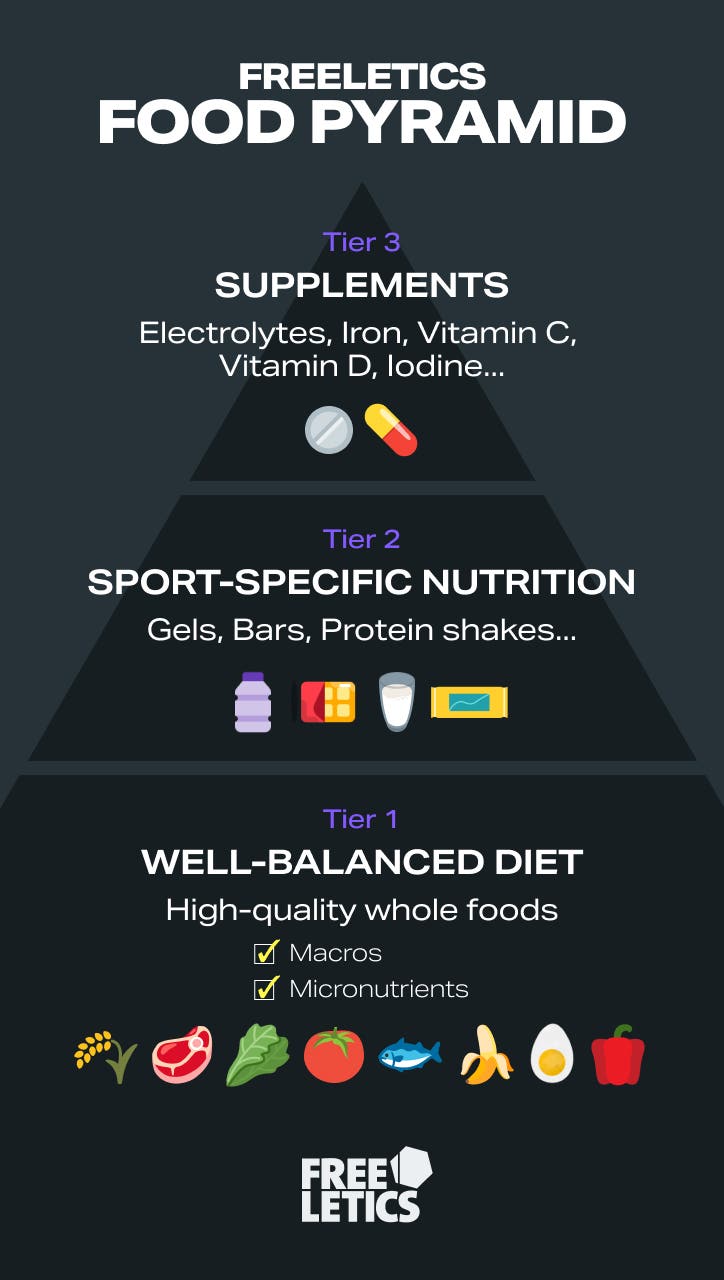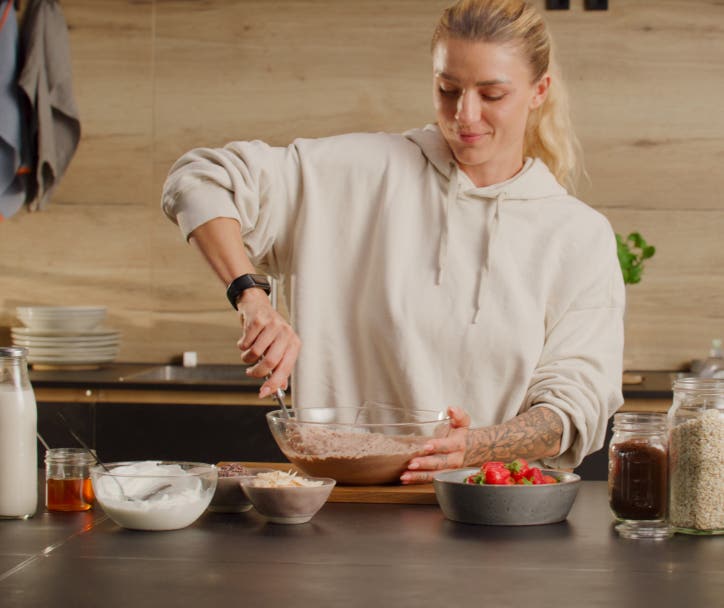We’ve already covered why fuel is important for runners (if you haven't yet, then hop – or run to it!). And while we know the critical role food plays in a runner's performance, what exactly should you be eating?
Don’t worry, we’ve got you. But before we dive into the nitty-gritty of the what/when/ and definitely do not, let’s get back to basics with a food pyramid. Forget the standard food pyramid; let’s dive into the Freeletics food pyramid, which adopts a sports nutrition perspective.
The Freeletics food pyramid
Understanding what makes up an ideal runner's diet is made easier with the visual food pyramid:

Tier 1 - Well-balanced diet
The pyramid highlights that the bulk of your diet should come from minimally processed, nutrient-dense whole foods to ensure you’re meeting your essential nutrient needs. If you’re aiming to run faster, further, or both – this tier should be your focus.
Remember, macronutrients play a crucial role in your performance and recovery:
Carbs
- Primary source of energy for exercise
- Stored as glycogen in muscles and liver for immediate use during exercise
Dietary fat
- Additional energy source, especially at low to moderate intensities
- Crucial for repairing cell membranes and supporting overall cell function
- Can reduce inflammation and support joint health
Protein
- Essential for muscle repair and recovery after exercise
- Important for maintaining muscle mass
Micronutrients are just as important. These essential vitamins and minerals play a critical role in energy metabolism, immune function, and overall health, helping runners maintain peak performance and stave off fatigue and injury.
While macronutrients fuel your run, micronutrients fine-tune your body's ability to perform at its best. This is why prioritizing a well-balanced diet serves as the foundation for optimal performance and health before moving to the next tier.
Tier 2 - Sport-specific nutrition
This section is secondary for a reason—it consists of foods and drinks to consume when your usual tier 1 options aren't accessible or convenient, like during a run or a race. This can include sports gels, bars, and protein shakes—basically anything that can help you get those calories in.
Tier 3 - Supplements
The top of the pyramid is a sprinkle of extras, or in other words, the dietary supplements that you might need if your diet is lacking or if you have specific performance goals to meet.
These supplements could include:
- Electrolytes: Maintain fluid balance and nerve function during exercise.
- Iron: Essential for oxygen transport in the blood, which is crucial for endurance and energy production.
- Vitamin C: Supports immune function and facilitates post-workout recovery from intense workouts.
- Vitamin D: Vital for bone health and muscle function.
- Iodine: Involved in regulating metabolism and energy levels during exercise.
Eating for running performance
When it comes to eating, especially for endurance events, timing is everything. And there’s a science behind meal timing. But as with all things health and fitness, you need to find what works best for you to gain performance benefits. Below we’ll explore what you should eat at different stages of a run.

What should you eat before a morning run?
If you’re an early riser and want to get out on your run, don’t skimp on that pre-run fuel. Opt for a small snack 30 to 60 minutes before you set off. A good pre-run snack has fewer calories than a meal and will consist primarily of carbs to keep your energy levels up.
Remember, it’s a snack, so you don’t want to overdo it. Especially if that means indigestion or other unwanted stomach problems mid-run. Here are some examples to inspire you:
- A piece of fruit, such as a banana
- Half of a sports energy bar
- 15 pretzels
- A handful of trail mix
- A couple of dates
What should you eat before an afternoon run?
If you’re heading out on a longer run mid-day, try to leave a window of about 2 hours after you’ve eaten before setting off. This will ensure you have the energy stores necessary to crush your miles, but also reduce the risk of experiencing digestive side effects.
Research shows that before a run, you should choose foods with a low glycemic index (GI). GI is a rating system for carbs showing how quickly the food will affect your blood sugar. Low-GI foods slowly release energy into your blood. Here are some examples:
- Fruit
- Oatmeal
- Eggs
- Low-fat yogurt
- Vegetables
- Beans
- Wholemeal pasta
- Nuts1
In fact, research involving eight recreational male runners found that consuming a low GI meal 3 hours before a run resulted in a higher endurance capacity compared to a high GI meal.2 For a low GI breakfast or brunch, you could try:
- Scrambled eggs and wholegrain bread
- A fruit smoothie
- Apple and cinnamon porridge
- High-fiber muesli or porridge oats with plant-based milk
What should you eat before an evening run?
For an evening run, the rule of thumb stays pretty much the same as an afternoon run. Choose low GI dinner options, like:
- Whole wheat pasta dishes, such as tuna pasta salad
- Chicken casserole
- Whole grain pasta with salmon and peas
- Bean soup
Foods to avoid before long runs
In addition to prioritizing meal timing, there are also some foods you should steer clear of if you want to feel your best on a run. These are foods that may cause digestive discomfort like diarrhea and cramps, so you should opt for a hard pass in the hours before your run:
- Fatty foods
- Spicy foods
- AlcoholCaffeine - can be helpful for performance, but too much can have adverse effects
What should you eat during a run?
Glycogen stores aren’t a running faucet, they deplete over time. On a long run you might deplete your glycogen stores within 1 to 2 hours.3 That’s why it’s essential to fuel on-the-go. But what is the best “intra-run” snack?
Whatever snack you choose, it should be accessible during your race or run, so ideally, something small enough to fit in your pocket or bag. Below we’ve included a few examples, plus the pros and cons of each option:
Gels:
Pros
- Easily digested
- High energy density
- Fast absorption
- Easy to carry
- Available in a variety of flavors
Cons
- Varying textures available - you’ll probably need to experiment to find one you like
- Most contain fructose, so not suitable if you’re allergic
- Can cause upset stomachs or digestive issues due to high-carb density
- Can be messy to open and eat while running
Bars:
Pros
- Slow and steady energy release
- Feels more like a snack as it requires you to “eat” it
- You can divide it into smaller portions to eat while on your run
- Available in different flavors, textures, forms, and brands
Cons
- If you need a quick release of energy, bars may not be ideal
- Their high fiber content risks digestive issues
- More difficult to eat because you need to chew them
- They may not be as easy to carry with you
- Can become crushed or warm or hard when it’s cold
Bananas:
Pros
- Lower inflammation - ideal for post-recovery4
- Quick release energy
Cons
- Hard to store on a run
- Difficult to eat as you need to peel it
Once you’ve picked your snack, it’s important to plan when you’ll eat it. Oftentimes, if you wait until you feel faint or out of energy, it’s already too late.
A good rule of thumb is to start fuelling about 30-40 minutes into your run, and then top up every 30 to 40 minutes thereafter. However, your fueling strategy is incredibly individual and can also depend on the distance of your run.
If you prefer energy gels, avoid consuming them all at once, as this can affect your tolerance. Instead, take the gel over a 4 to 5-minute period, and don’t forget to stay hydrated – another key, yet often overlooked, component of a runner’s nutrition.
Post-run nutrition
Once your run is over, no matter the distance, it’s time to think about your recovery. Aim to eat within 30 minutes post-run to aid in recovery and to help your muscles repair.
Some research shows that high carbohydrate intake after exercise can replenish glycogen to pre-exercise levels within 24 hours.5 If you want to add protein to your post-run snack, you should aim for:
- around 0.8 g of carbohydrates per kg of body weight to help restore muscle glycogen stores
- up to 0.4 g of protein per kg of body weight to help repair and build muscles.
If you have a high carb intake (>1.2 g/kg), then adding protein will have no greater effect on your glycogen levels.6,7
Need some post-run meal inspiration? Give these simple, nutrition-packed ideas a go:
- Granola with Greek yogurt
- Protein shake made with dairy or oat milk
- Chocolate milk and a cereal bar
- Banana with peanut butter
- Quinoa salad
- Turkey sandwich
- Eggs on toast

Let’s recap
If you want to become a stronger, faster, and better runner, fueling right is a key part of the puzzle. And it’s not only the what that matters, but also the how and when. And a lot of discovering what works best for you, your stomach, and your runs will come down to trial and error. But trust us, if you can get your fuel strategy down pat, all the other pieces will fall into place. Better yet, you’ll be that much closer to chasing down that PB or crushing that distance goal.